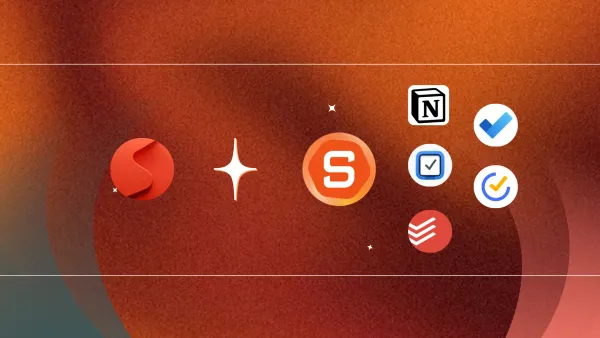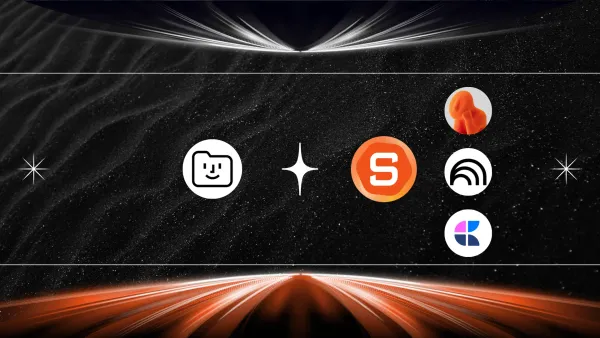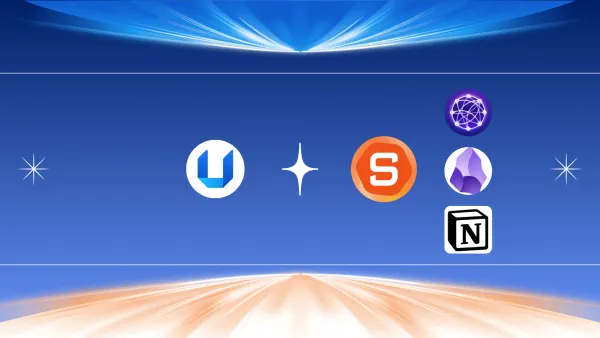How to build your Personal Knowledge Management System [Full Guide 2025]
The Best Personal Knowledge Management Apps are Saner.AI, Notion, Obsidian and Heptabase

Personal Knowledge Management System - The must in 2025
We live in an age of overwhelming information. Articles, podcasts, videos, notes, and ideas come at us faster than we can process them. If you’re an entrepreneur, creator, student, or knowledge worker - you’ve probably had this thought: “I’ve seen this before… but where did I save it?”
A Personal Knowledge Management System (PKMS) helps you answer that question. Think of it as your digital second brain - a structured way to capture, organize, retrieve, and synthesize everything you learn, so nothing gets lost and your brain can focus on thinking, not remembering.
Let’s dive into how to build your own.
What is a Personal Knowledge Management System (PKMS)?

A Personal Knowledge Management System is a method - often supported by digital tools - to manage your personal information and ideas. It allows you to:
- Capture ideas as they arise
- Organize them in ways that make sense to you
- Retrieve them when needed
- Synthesize new insights from what you’ve saved
- Share knowledge or collaborate with others
Whether you’re building a startup, writing a book, or researching a complex topic, a PKMS lets you offload memory tasks so you can focus on creativity and execution.
Why it Matters More Than Ever
We're bombarded by information daily. The average person consumes over 74 GB of content per day. Most of it slips through the cracks unless actively saved and processed.
A strong PKMS helps:
- Reduce context switching and decision fatigue
- Prevent duplicated effort (“Did I already research this?”)
- Build long-term value from your learning
- Support mental clarity and reduce overwhelm—especially helpful for people with ADHD
Who Benefits from a PKMS?
While everyone can benefit, PKMS especially empowers:
🚀 Entrepreneurs: Juggling strategy, customers, team notes, and insights from books? A PKMS can link it all together so you spot patterns and act faster.
🧠 Researchers & Academics: Track sources, literature notes, hypotheses, and long-term questions - without re-reading the same paper three times.
✍️ Creators & Writers: Manage drafts, content ideas, references, and your creative process from one place.
🧩 ADHDers & Neurodivergent Thinkers: Structure and surface the right info at the right time without relying on working memory or messy notebooks.
How to build a Personal Knowledge Management System
1. Identify your sources of information

Before you organize anything, figure out where your knowledge is coming from. Some common sources of personal knowledge include:
- Books and academic journals
- Podcasts, YouTube videos, and online courses
- Blogs, news articles, and forums
- Emails, meeting notes, and voice memos
- Real-world experiences and conversations
Your personal knowledge base will evolve based on what you're learning and working on. That’s why identifying key sources upfront - whether it's for research, writing, or idea capture - is essential for shaping a relevant and sustainable system.
✅ Pro Tip: Start with just 2-3 main sources you rely on frequently, then expand as needed.
2. Choose the Right Tools for Your PKMS
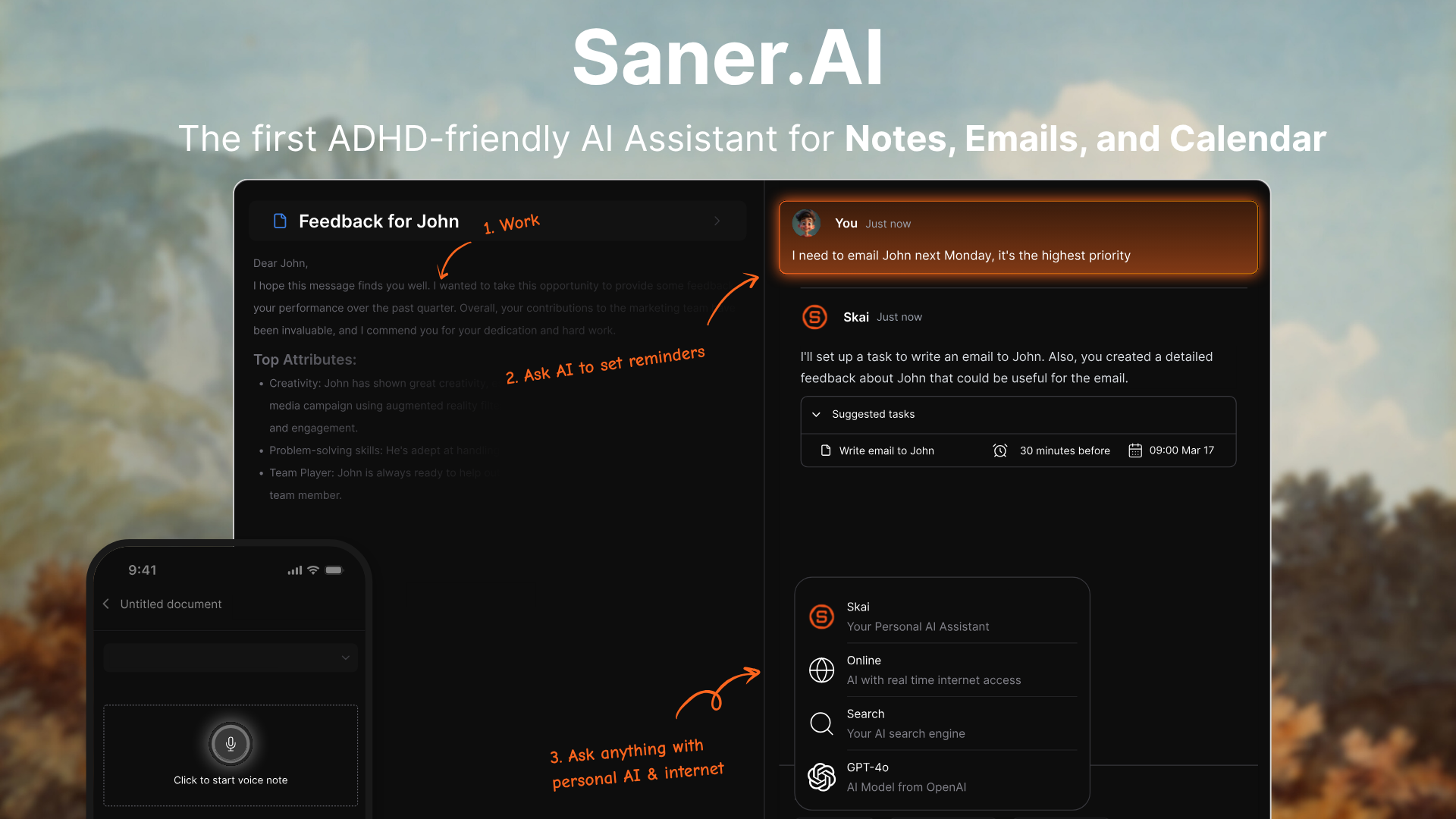
The best personal knowledge management system is one that’s easy to use and fits your style of thinking.
Core Tool Types to Consider
📝 Note-Taking Apps
- Ideal for capturing ideas, summarizing articles, and writing daily notes.
- Popular options: Saner.AI, Notion, Obsidian, Google Keep
🧠 Mind Mapping Tools
- Great for visual learners and conceptual thinkers.
- Use them to connect ideas and create big-picture overviews.
- Try tools like XMind, MindMeister, or Whimsical
☁️ File Storage Platforms
- Keep documents, images, PDFs, and research in a central, searchable place.
- Common tools: Google Drive, Dropbox, iCloud
🤖 AI PKMS
- These systems go beyond storage - they help you synthesize and retrieve knowledge automatically.
- Tools like Saner.AI offer automatic AI tagging, semantic search, and resurfacing forgotten ideas.
3. Create a Flow for Organizing and Connecting Ideas

Once you’ve chosen your tools, it’s time to build a lightweight structure to manage the flow of knowledge.
🗂️ Categorize Your Knowledge
Think of categories as broad shelves - group content by purpose, topic, or source:
- Topic-based: “Marketing,” “Neuroscience,” “Personal Growth”
- Purpose-based: “Reading Notes,” “Project Ideas,” “Meeting Summaries”
- Framework-based: PARA (Projects, Areas, Resources, Archives)
Keep categories simple at first. You can always add more structure as your PKMS evolves.
🏷️ Use Smart Tags for Quick Retrieval
Tags are your secret weapon for fast search. Use them to add context and keywords:
- Type:
#booknote,#idea,#summary - Topic:
#AI,#productivity,#mentalmodels - Status:
#in-progress,#finalized,#to-review
4. Let AI Streamline the Workflow
AI is transforming the way personal knowledge is managed. Here's how it helps:
🔍 Smarter Search
Instead of remembering where you stored something, AI-powered search tools understand the meaning of your query and deliver relevant notes—even if the keywords don’t match exactly.
For example:
“What were my thoughts on cognitive load theory?”
can bring up notes from a book you read six months ago.
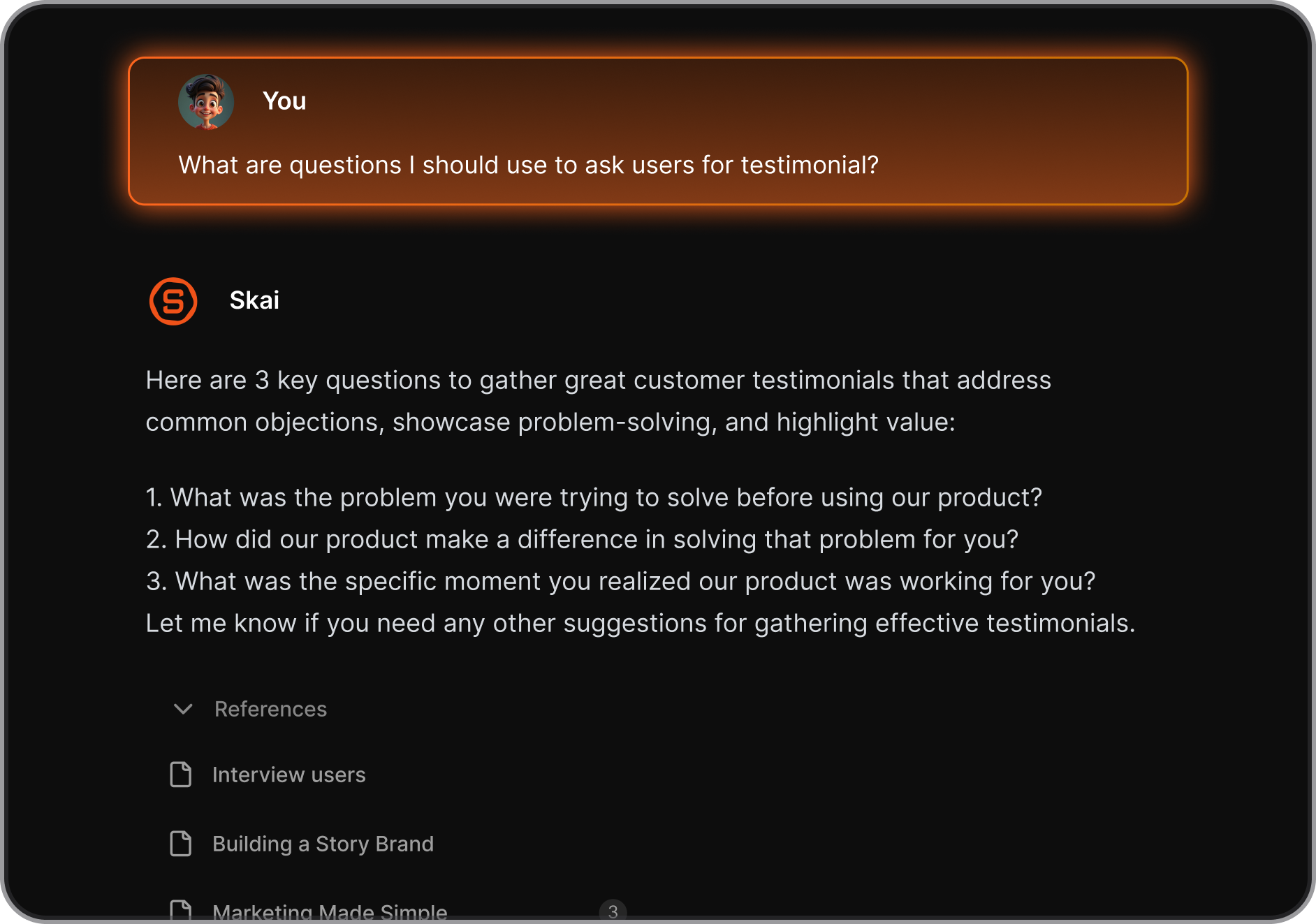
🧠 Automatic Tagging and Classification
Manually tagging everything? Let AI do the work. Tools like Saner.ai analyze your notes and apply smart, context-aware tags.
📅 Context-Aware Reminders
Modern PKMS apps are beginning to use AI to resurface old knowledge when it’s most relevant - like when you're working on a related task or calendar event.
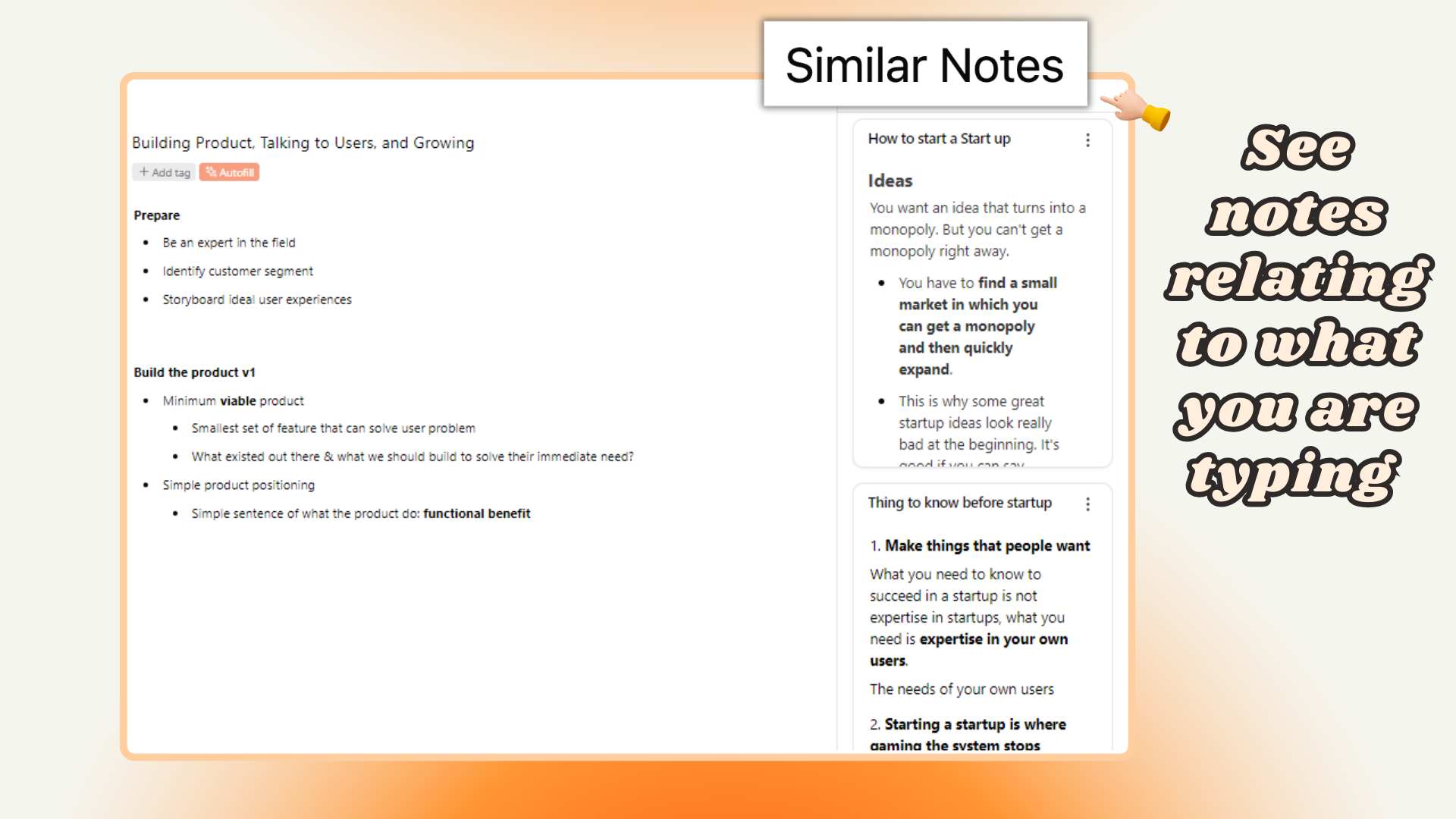
AI turns your personal knowledge from static files into a living, learning assistant.
5. Review and Refactor Regularly

A personal knowledge management system is never “done.” It’s a dynamic ecosystem that thrives with regular review.
🧽 Why Regular Reviews Matter
- Declutter outdated or irrelevant info
- Discover patterns by connecting old ideas with new ones
- Reinforce memory and deepen understanding
- Adapt your structure to fit evolving goals
📅 How to Maintain Your PKMS
- Set a review schedule (weekly, monthly, or quarterly)
- Update or archive notes that are no longer useful
- Revise tags/categories as your system matures
- Explore connections between past and current projects
Think of your PKMS like a garden. Prune regularly, and it will grow into a powerful thinking tool.
6. Share Your Knowledge with Others (Optional)
Sharing what you learn doesn’t just help others—it deepens your own understanding and makes your insights more actionable.
💬 Why Sharing Matters
- Clarifies your thinking
- Encourages feedback and collaboration
- Reinforces learning through teaching
- Builds personal brand or trust with your audience
📣 How to Share Effectively
- Start a blog, Twitter thread, or LinkedIn post about a concept you’ve learned
- Host a lunch & learn or team knowledge share
- Document SOPs or tutorials based on your notes
- Encourage feedback and expand your thinking through others' insights
In a world of fast content, thoughtful synthesis is rare—and incredibly valuable. Your PKMS is a great source of that value.
What are the Best Personal Knowledge Management Apps?
The Best Personal Knowledge Management Apps are Saner.AI, Notion, Obsidian and Heptabase
1. Saner.AI
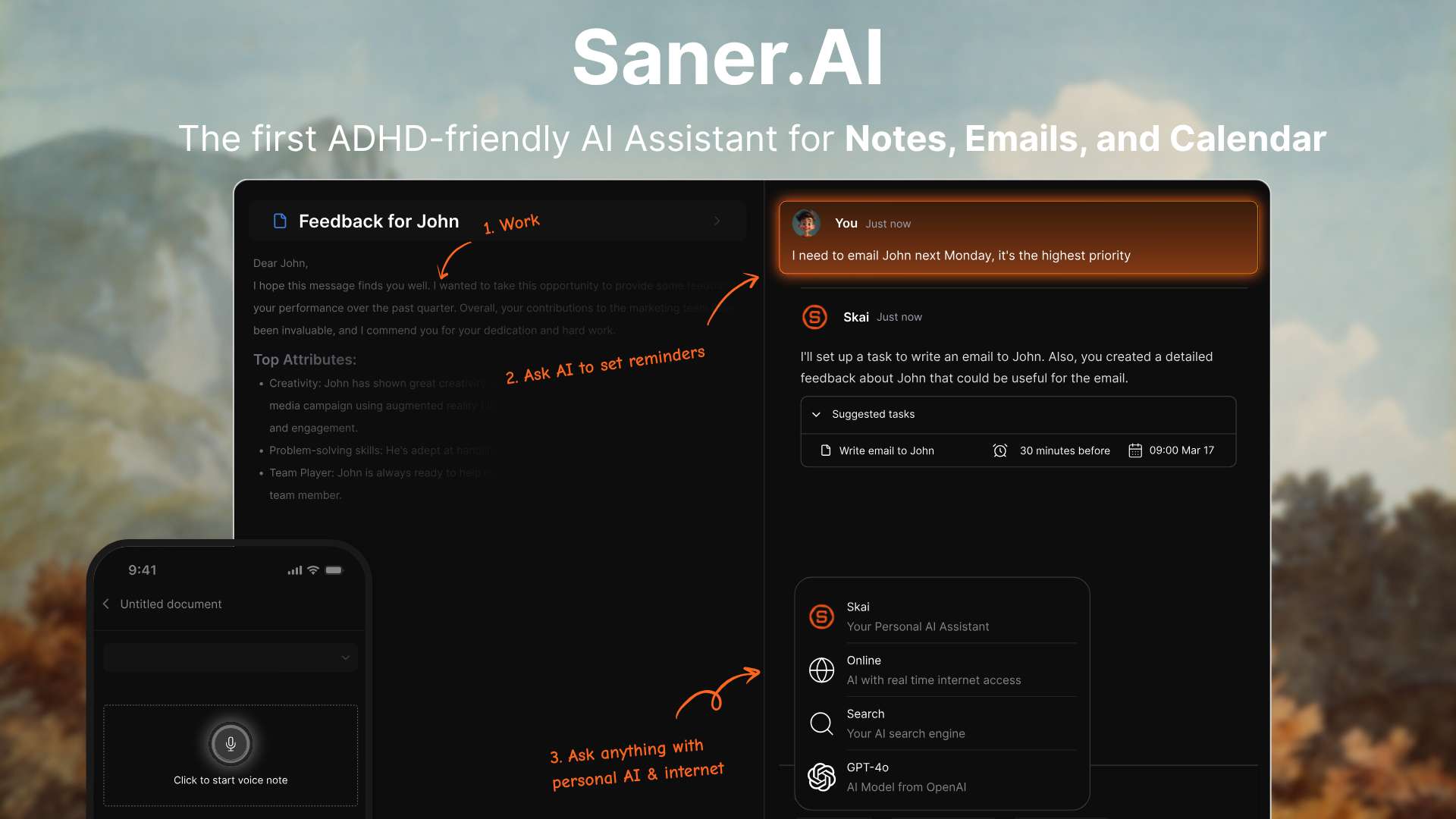
Saner.AI is an AI personal knowledge management system that actually helps me remember what I know. It connects all my scattered thoughts - notes, emails, web highlights - and makes them searchable, understandable, and usable. It’s designed by people with ADHD
If you’ve ever felt overwhelmed by your own information, this is the tool you’ve been waiting for.
Key features
- AI Assistant (Skai): I can just ask it to summarize, find connections, or explain anything I’ve saved. It feels like having a second brain that actually knows me.
- Quick Capture Tools: I use the Chrome sidebar to clip anything - articles, PDFs, emails - without breaking flow.
- Auto Organization: It suggests tags and organizes things into folders or visual maps. I barely have to manage anything manually.
- Smart Search & Synthesis: It doesn’t just “find” - it makes sense of my info and surfaces insights I forgot I had.
- ADHD-friendly Interface: Clean, minimal, distraction-free. No clutter, no overload.
- Integrations: Works with Gmail, Drive, Slack, Calendar, and more—everything ends up in one place.
What I liked
- It truly works like an AI Second Brain. I can write a messy note, and Saner figures out what it means and how to organize it.
- The task assistant is a lifesaver. I can just brain dump: “Follow up with Sarah next week” - and it schedules it for me.
- I love that it syncs with Gmail, Drive, Slack, and more. Everything is searchable in one place.
- The interface is built for focus. No clutter, no distractions.
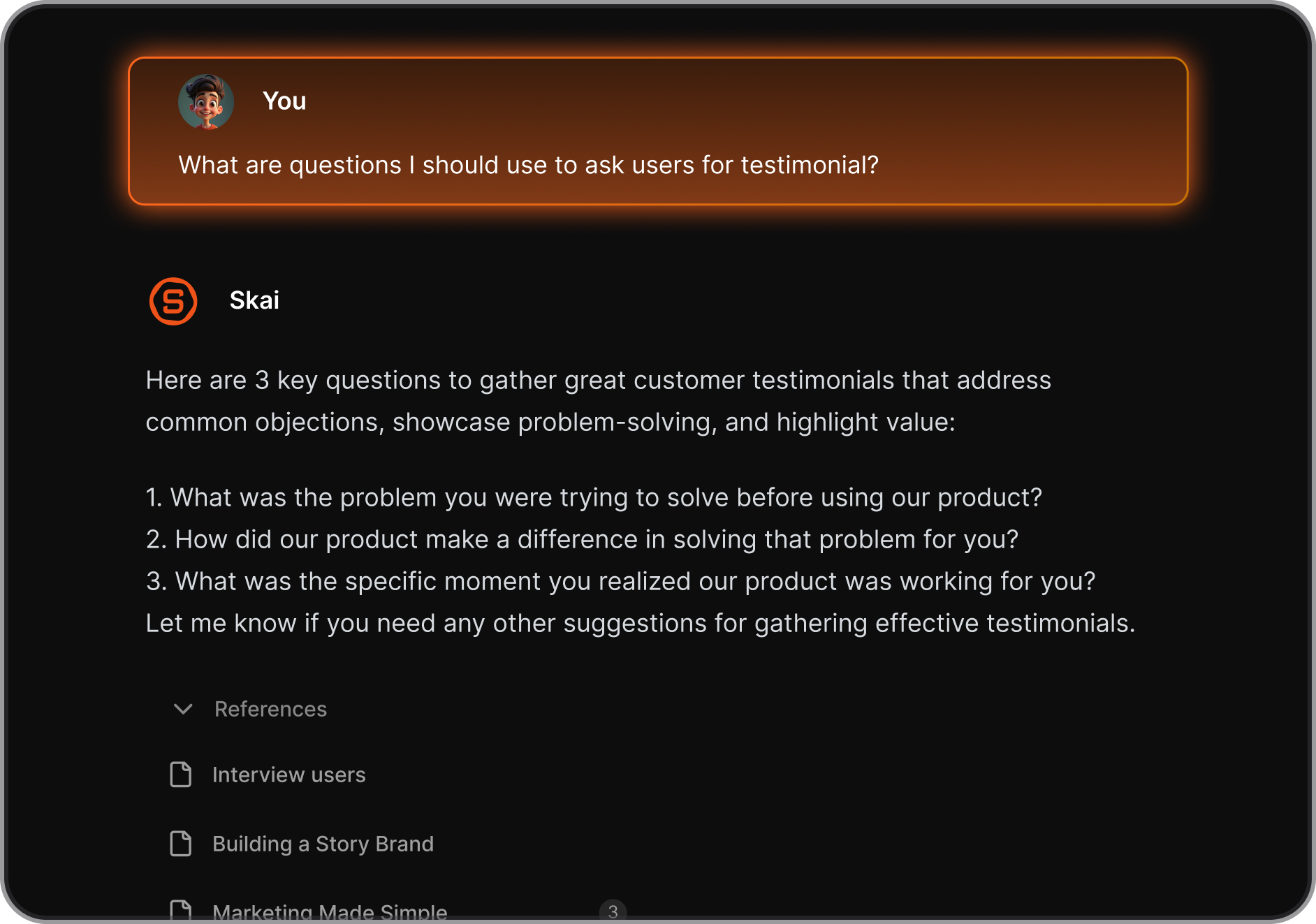
Cons
- Requires internet access for full functionality.
Pricing
- Free
- Starter: Monthly at $8/month, Annually at $6/month (with early user discount)
- Standard: Monthly at $16/month, Annually at $12/month (with early user discount)
Suitable for
- Anyone building a second brain
- Researchers, founders, thinkers who need to remember what they know
- Neurodiverse folks who want simplicity, not more overwhelm
Saner.AI Reviews

How to start
Just go to Saner.AI, make a free account, connect your notes, and start chatting with Skai. The AI will help you organize without the usual friction.
The top PMKS for you notes, tasks and emails
2. Notion
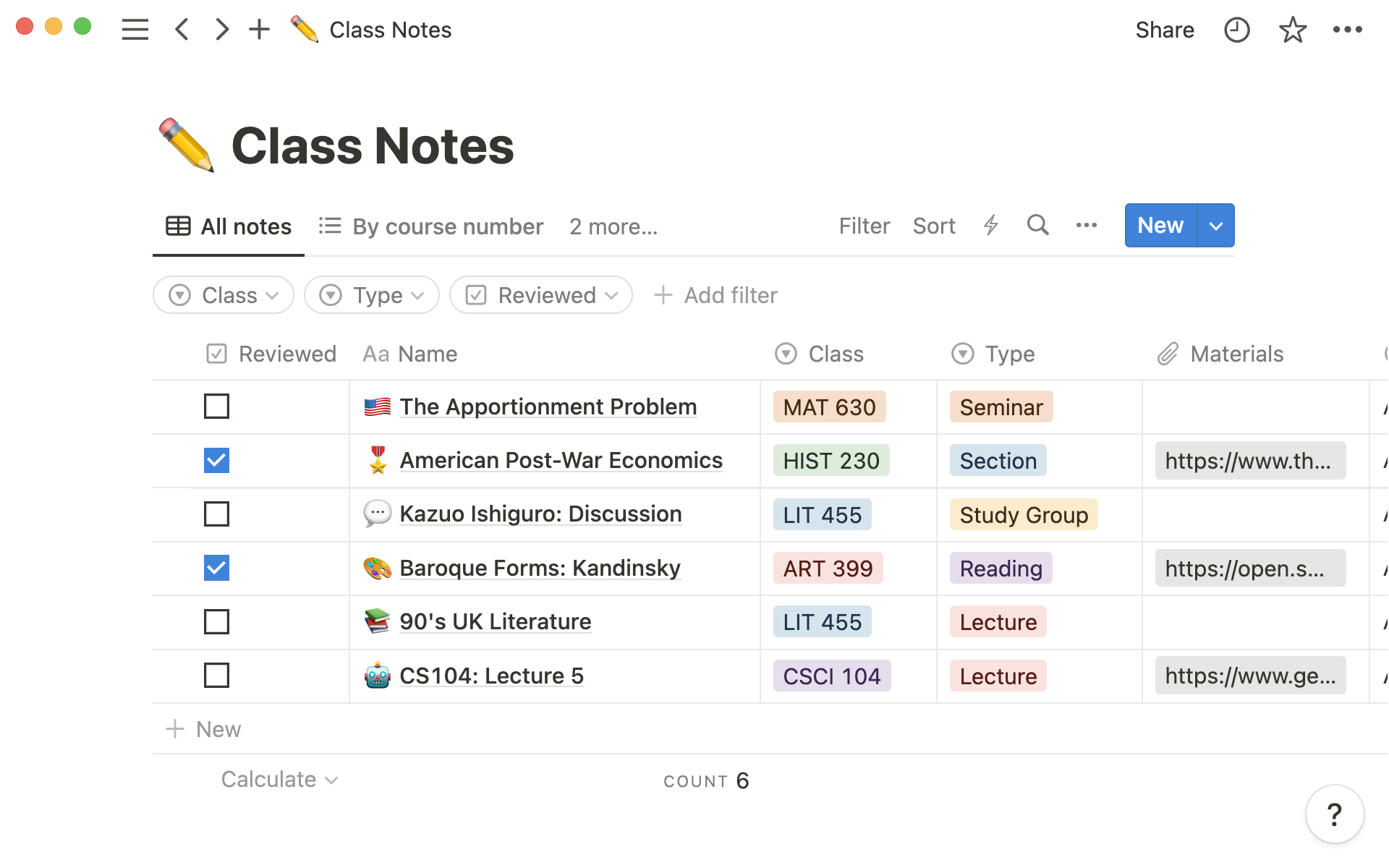
Notion is an all-in-one workspace that makes Personal Knowledge Management flexible. It lets you create your own system for organizing notes, tasks, wikis, and databases.
It’s good if you want a central place to store and connect everything you’re learning, thinking about, or working on.
Key features
- Customizable pages and databases: Build your own structure using tables, calendars, kanban boards, and more
- Linked notes and wikis: Create a connected knowledge system with backlinks and nested pages
- Templates: Use or customize templates for PARA, Zettelkasten, journals, and more
- Collaboration: Share pages, comment, and edit in real time
What I liked
- I like how flexible it is.
- Everything lives in one place. I don’t have to switch between note apps, task tools, or docs.
What I disliked
- It takes some effort to get started. The blank page can feel overwhelming at first.
- Offline access is limited, which isn’t great if you’re often without internet.
- If you have a massive workspace with tons of content, things can slow down.
Pricing
- Free for individuals with unlimited pages and blocks
- Plus plan: $8/user/month
- Business plan: $15/user/month
Suitable for
- Anyone building a second brain or Personal Knowledge Management system
- Creators, entrepreneurs, researchers, and knowledge workers
- Small teams that want to combine notes, docs, and tasks in one place
How to start
Just go to Notion, create a free account, and start with a simple page or template. You can build your system as you go
Notion reviews (source)

3. Heptabase

Heptabase is a visual-first Personal Knowledge Management tool that helps you organize complex ideas using cards and whiteboards. It feels like working with sticky notes on an infinite canvas - but everything's connected and searchable.
It’s great for people who think in visuals and want to build a second brain for complicated matters
Key features
- Card-based notes you can place anywhere and link together
- Whiteboards to map out research, ideas, and topics visually
- PDF and video support - you can highlight and pull content straight into your notes
- Tags and properties to organize info like a database
- Multiple views for structured thinking
- Works offline, with sync across desktop and mobile
What I liked
- The whiteboards help me actually see how your ideas connect,
- I can highlight PDFs and turn quotes into connected cards
- Everything is reusable - one card can live in multiple contexts without duplication
- It’s fast, clean
What I disliked
- Mobile is a bit clunky - editing or creating cards on the go still needs work
- No Zotero integration, so academic workflows feel a bit manual
- Exporting to Markdown loses some structure
- Not built for heavy-duty project management—no task dependencies or timelines
- No AI assistant
Pricing
- Free 7-day trial
- $11.99/month or $8.99/month billed yearly
Suitable for
Researchers, writers, students, and anyone building a visual personal knowledge system. Probably not for people who live on their phone or need tight project tracking.
How to start
Go to Heptabase.com, grab the free trial, and start with one board. I made a “Topics” board and added cards for each idea I’m exploring. Everything else clicked from there.
Heptabase review (source)
4. Obsidian
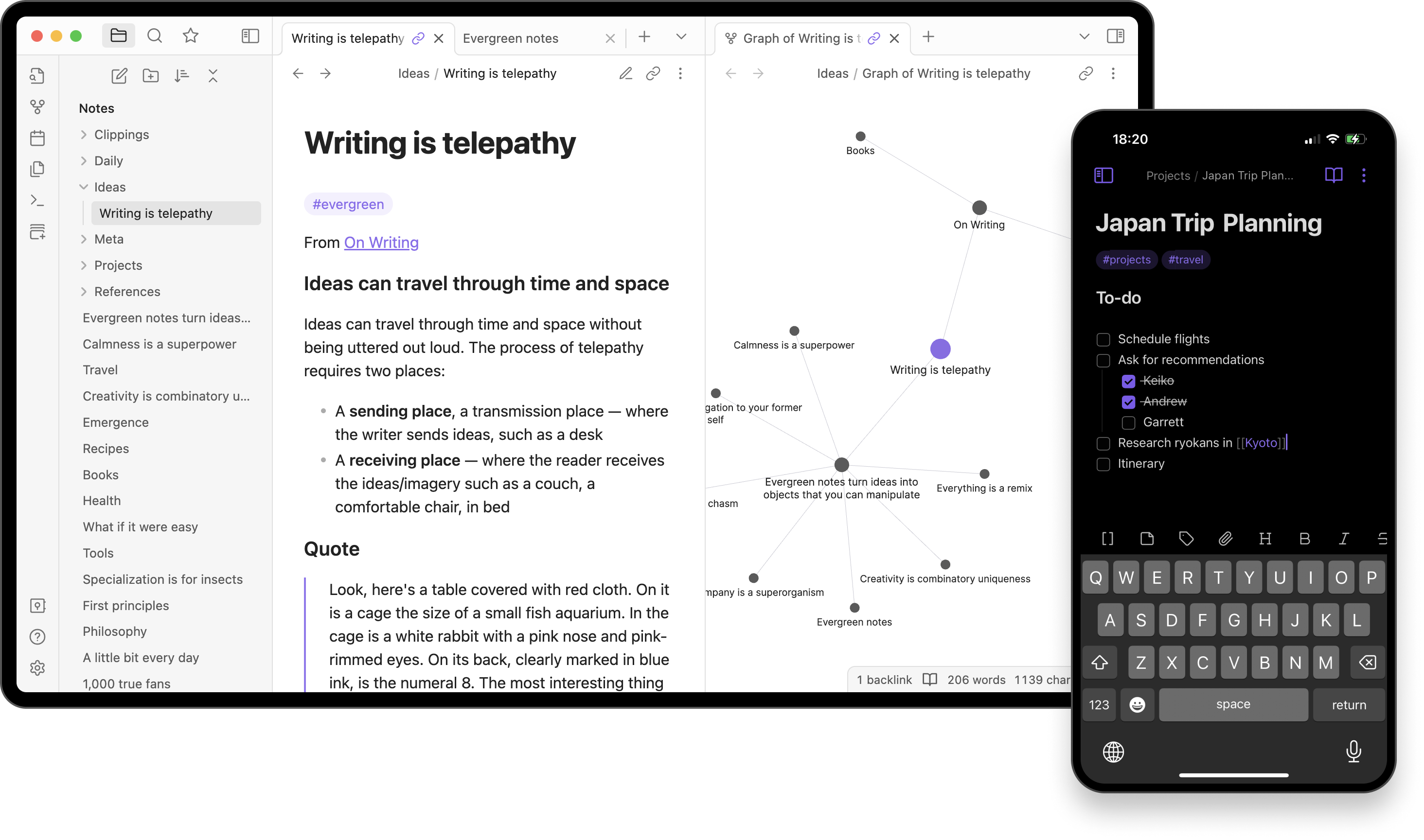
Obsidian is a local-first, markdown-based note-taking app that helps you build a personal knowledge management system that actually grows with you.
It’s perfect if you want full control of your notes and like the idea of connecting thoughts instead of just filing them away in folders.
Key features
- Local markdown files: everything lives on your device, not in the cloud
- Bi-directional linking: connect ideas across notes, like building your own internal Wikipedia
- Graph view: visualize how your ideas relate to each other
- Canvas: a freeform space for visual thinking—great for mind maps or planning
- Plugin ecosystem: over 200 plugins for task management, spaced repetition, daily notes, and more
- Optional sync and publish: encrypted sync across devices or turn notes into a public site
What I liked
- I like how Obsidian lets me link ideas together
- It’s super customizable with lots of plugin
- And since everything is local, I don’t have to worry about losing access or paying for basic features.
What I disliked
- It took me a while to set it up the way I wanted. There’s definitely a learning curve.
- The mobile app exists, but it’s slower and a bit clunky compared to desktop.
- Out of the box, it’s just a plain text editor—you’ll need plugins to unlock the magic.
- If you prefer a simple, structured app, this might feel too open-ended.
Pricing
- Free for personal use
- $8/month for Obsidian Sync (optional)
- Paid add-ons for Publish or commercial use
Suitable for:
Writers, researchers, thinkers, or anyone who wants a powerful personal knowledge management system that’s private, flexible, and built to last.
How to start:
Just download Obsidian, create a vault, and start with a few simple notes. Add links as you go—and let your second brain grow from there.
Obsidian review (source)

5. Coda

Coda is a all-in-one doc that blends notes, databases, spreadsheets, and apps. It’s a great choice for Personal Knowledge Management if you like your knowledge base to be structured, connected, and a bit more interactive than your average note-taking tool.
It’s ideal for creators, thinkers, and knowledge workers who want to organize ideas, track learning, and build their own systems
Key features
- Linked tables: Create structured knowledge bases where notes, resources, and ideas are all connected
- Buttons & automations: Build your own workflows (like tagging, archiving, or task progress) with a click
- Multiple views: Switch between Kanban, table, calendar, and gallery views depending on your project
- Packs: Integrate with tools like Google Calendar, Slack, Jira, and more
What I liked
- I like how customizable Coda is.
- I also like that I can visualize my knowledge in different ways: Kanban for projects, calendar for learning sessions, and tables for resources.
What I disliked
- There’s a bit of a learning curve. If you’re just looking for simple note-taking, this might feel like overkill.
- It doesn’t work offline, which can be frustrating if you’re traveling or want full control of your data.
- It’s not built specifically for PKM, so you won’t get native graph views or backlink-first thinking like you do with tools like Obsidian.
Pricing
- Free plan available
- Pro: $12/month per doc maker
- Team: $36/month per doc maker
- Enterprise: Custom pricing
Suitable for
People who want to build a personal knowledge management system that’s flexible, visual, and connected—without writing code.
How to start
Go to coda.io, create a free account, and explore their PKM templates to start building your system.
Coda review (source)

6. Logseq

Logseq is a free, open-source Personal Knowledge Management tool built for people who want full control over their notes. It’s a local-first outliner that helps you connect thoughts, organize tasks, build a second brain, and even study with flashcards
It’s great if you’re serious about note-taking, learning, or long-term thinking.
Key features
- Block-based outliner: Every note is a bullet you can nest, tag, and link
- Bi-directional linking: Connect ideas across your notes with ease
- Daily journaling: Start each day with a clean page to capture thoughts and tasks
- Flashcards: Turn notes into spaced repetition cards with one tag
- Graph view: Visualize how your knowledge connects
What I liked:
- The outliner format keeps everything structured without extra effort
- Flashcards are built-in, so I can review what I’ve learned over time
- I don’t need to worry about privacy or sync issues
- There's a strong community constantly improving the experience
What I disliked:
- It’s not the most beginner-friendly app—there’s a learning curve
- The mobile app is a bit clunky and lacks some desktop features
- Large graphs or complex queries can slow things down
- Compared to other tools like Obsidian, the plugin ecosystem is smaller
Pricing:
- Totally free. No paid plans.
Suitable for:
People who want a powerful, flexible Personal Knowledge Management system—especially note-takers, researchers, and self-learners who value privacy and customization.
How to start:
Just go to logseq.com, download the app, and start journaling. It works right out of the box with your local files.
7. Capacities
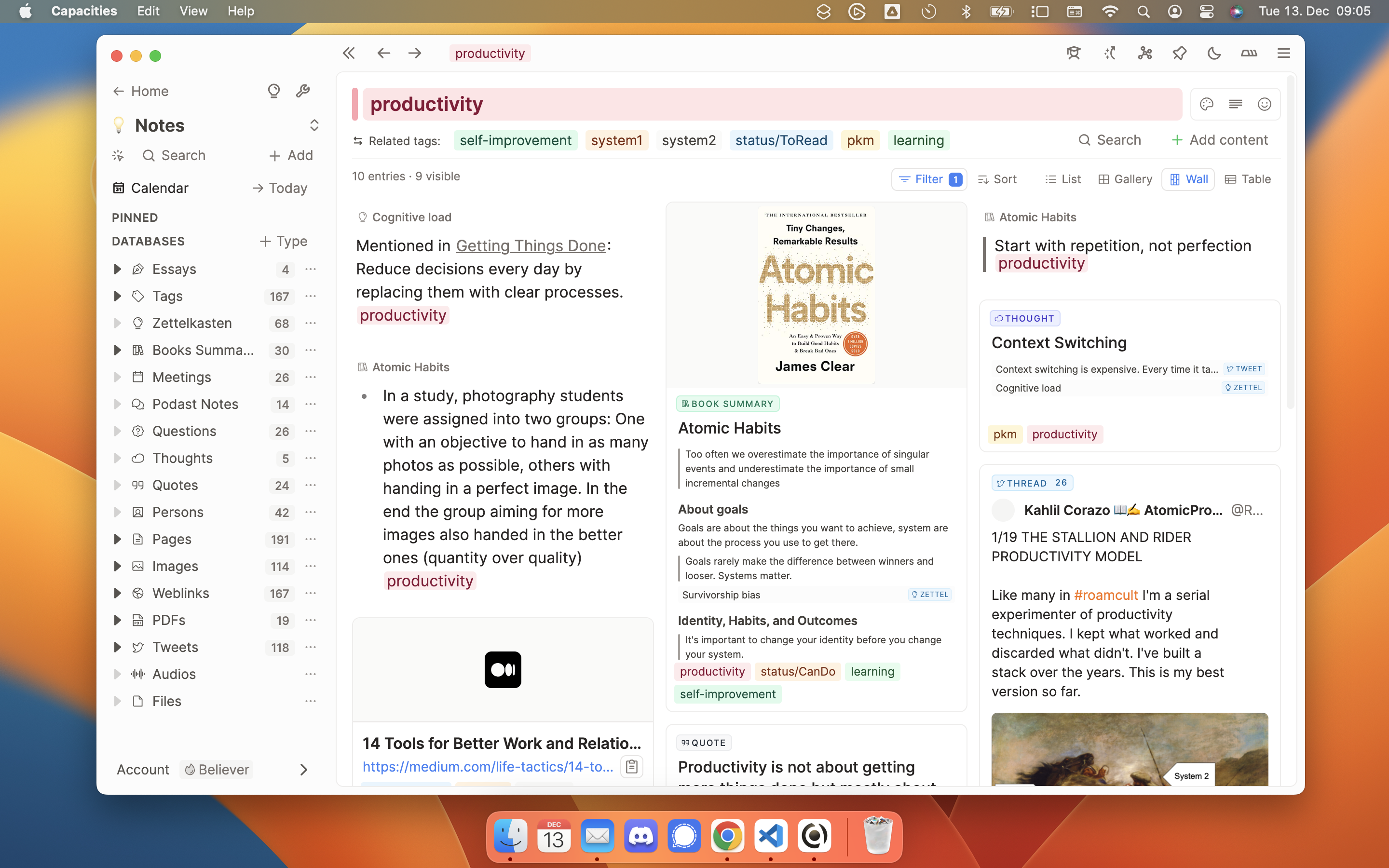
Capacities is a modern Personal Knowledge Management system that helps you capture, connect, and organize your thoughts with ease. It’s built around the idea of turning everything—notes, tasks, ideas—into “objects” you can customize and link together.
Key features
- Object-based notes: Turn anything into a structured “object” like a book, meeting, or idea
- Daily notes: Built-in journaling that helps you track progress and log your thinking
- Templates: Use prebuilt templates to keep your notes consistent
- Cross-platform capture: Works on desktop and mobile for quick capture on the go
What I liked
- The way it links notes is powerful.
- Daily notes helped me stay consistent. I
- It looks great. The clean interface made it feel more like a calm workspace
What I disliked
- The mobile app still has a few bugs—it’s fine for quick capture, but editing can feel clunky.
- Everything is cloud-based, so you don’t have full offline control unless you’re on a paid plan.
- There’s a bit of a learning curve when you first start setting up objects and templates.
- There's no AI assistant for your tasks, calendar, emails like with Saner.AI
Pricing
- Free plan
- Pro plan around $10–12/month,
Suitable for
Writers, researchers, and knowledge workers who want a structured, visually clean way to manage their ideas without getting lost in complexity.
How to start
Head to Capacities, create a free account, and explore daily notes and object templates to kick off your Personal Knowledge Management journey.
Capacities Review (source)

8. Reflect

Reflect is a lightweight, privacy-focused notes app designed for personal knowledge management. It combines networked thinking, and a clean interface to help you capture, connect, and rediscover ideas without the clutter.
Key features
- Networked notes: Create bi-directional links and see how your thoughts connect over time
- Daily notes: A central place to think, plan, and track what’s on your mind
- End-to-end encryption: Everything is private, and syncs securely across web, Mac, and iOS
- Web clipper & Readwise sync: Easily pull in highlights, Kindle notes, and articles
What I liked
- The UI is fast and distraction-free.
- Backlinking is intuitive.
- Daily notes make it easy to reflect and track progress without needing a complex system.
What I disliked
- No free plan, and you have to pay annually — which feels like a big ask if you're just testing it out
- Task management is very basic. If you rely on complex to-do workflows, you’ll need something else
- AI Assistant is pretty basic
Pricing
- $10/month (billed annually)
- 14-day free trial, no free tier
Suitable for
- People who journal or take daily notes
How to start
Just sign up for the free trial, set up your daily notes, and start writing. It works best if you build the habit of writing a little each day — Reflect handles the rest.
9. Anytype

Anytype is a privacy-first tool for Personal Knowledge Management.
It works offline, stores everything locally, and lets you build a connected knowledge base with total control over your data. Unlike cloud tools, it’s fully end-to-end encrypted and syncs peer-to-peer between your devices.
Key features
- Local-first storage with end-to-end encryption
- Object-based PKM: notes, tasks, bookmarks, and files are all linked in a knowledge graph
- Recent update: files can now be used as rich objects with metadata
- Offline-first, with sync once you're back online
- Shared spaces for small-scale collaboration
What I liked
- The local-first, encrypted setup means I own my data completely
- It's flexible: I can use tables, Kanban, or graph view depending on the project
- The community is active and the product is improving fast
What I disliked
- It takes a bit to wrap your head around the object-based structure
- Some features, like real-time collaboration, are still in early stages
- The mobile app is decent, but still behind the desktop version
- Exporting content isn’t as straightforward as I’d like
- No AI assistant yet
Pricing
- Free Explorer plan available
- Builder plan around $8/month
- Co-Creator plan around $299 for 3 years
Suitable for
People who care deeply about Personal Knowledge Management, especially researchers, knowledge workers, and privacy-minded users who want a local-first alternative to Notion or Obsidian.
How to start
Download Anytype, set up your local space, and start creating objects for your notes, tasks, and ideas. The graph view helps you see how everything connects.
Anytype review (source)

10. Workflowy

Workflowy is a minimalist note-taking app built around bullet points. It’s great for people who think in outlines and want a distraction-free space to map out their ideas.
Key features
- Infinite nesting: Organize thoughts in endless bullet layers—perfect for structuring knowledge
- Mirrors: Sync a bullet across multiple places so edits show up everywhere
- Tags and search: Quickly jump to anything with #tags or keywords
- Kanban view: Turn lists into boards when needed
- File embedding: Drop images, videos, or PDFs directly into your notes
- Markdown support: Format notes cleanly with bold, bullets, and even code blocks
What I liked
- I like how fast and focused Workflowy feels.
- I can reference the same idea in multiple projects without duplicating.
- It works great for Personal Knowledge Management.
- The minimal design keeps me from getting overwhelmed.
What I disliked
- The mobile app is a little clunky - feels more like a web wrapper.
- If you want reminders or calendar sync, you’ll need another tool.
- There’s a 250 bullet limit on the free plan, which I hit pretty quickly.
- Accidentally dragging or deleting bullets can happen easily if you're not careful.
- No AI Assistant yet
Pricing
- Free plan: 250 bullet limit
- Pro: $4.99/month or $49/year — unlimited bullets, backups, themes
- Team: $8/user/month — everything in Pro plus collaboration tools
- Discount: Students and nonprofits get 50% off
Suitable for
Writers, thinkers, students, and anyone building a second brain. Especially helpful if you want a lightweight Personal Knowledge Management system without the clutter.
How to start
Head to workflowy.com, sign up for free, and start outlining. You’ll get the hang of it fast - and you can always upgrade later.
Workflowy review (source)

Conclusion
Setting up a Personal Knowledge Management System (PKMS) is a smart move for anyone who wants to handle information better and make smarter decisions.
We've gone through what PKM is all about and highlighted some of the best apps out there to help you get started. These tools are designed to make it easier for you to sort, store, and use your knowledge effectively.
Stay on top of your work and life with a PKMS
Personal Knowledge Management System FAQ
1. What is a Personal Knowledge Management System?
A Personal Knowledge Management System (PKMS) is a tool or process you use to collect, organize, and make sense of the information in your life. It helps you keep track of ideas, notes, tasks, documents, and learning in one place - so your brain doesn’t have to.
Whether you're an entrepreneur, researcher, or busy professional, a PKMS can support how you think, plan, and create. Instead of scattered docs, browser tabs, or sticky notes, everything lives in a trusted system.
Examples of PKMS tools include Notion, Obsidian, Logseq, and newer AI-powered ones like Saner.AI.
2. Why should I use a Personal Knowledge Management System?
Here’s why more people are building one:
- Stop forgetting things – Capture ideas before they vanish
- Connect the dots – Link notes across projects and topics
- Think clearly – Offload mental clutter and reduce overwhelm
- Work faster – Find what you need without hunting through apps
With a good PKMS, your thoughts don’t disappear, they compound.
3. What does a good Personal Knowledge Management System include?
A modern PKMS often includes:
- Note-taking (with backlinks, tags, or folders)
- Task and project tracking
- Search that actually works
- Connections between ideas
- A calm interface that fits your brain
Some systems also add AI to help you summarize, search, or generate content - like Saner.AI or Reflect.
4. How is a Personal Knowledge Management System different from a regular note-taking app?
Note-taking apps store information. A PKMS helps you use it.
- With a PKMS, your notes talk to each other
- You don’t just capture - you connect, recall, and act
- It’s not just a notebook - it’s your thinking space
5. Can AI improve my Personal Knowledge Management System?
Yes. AI is changing how we manage knowledge.
AI-enhanced PKMS tools like Saner.AI can:
- Understand what your messy notes mean
- Surface relevant content when you need it
- Turn unstructured thoughts into organized action
- Reduce context switching by pulling info from multiple places
Instead of searching, you ask. Instead of sorting, it helps sort for you.
6. What are examples of Personal Knowledge Management Systems?
Here are a few popular tools people use:
- Notion – Flexible workspace, but manual linking and tagging
- Obsidian – Local-first, graph view, great for power users
- Logseq – Open source and outline-first
- Saner.AI – AI-powered system that connects notes, tasks, and calendar
Each works differently. The best one depends on your brain.
7. Is a Personal Knowledge Management System good for ADHD?
Yes. In fact, people with ADHD often benefit the most from PKMS tools—especially ones that reduce friction like Saner.AI
Helpful features include:
- Natural language input (“remind me to send follow-up”)
- AI summarization (to shorten long notes or meetings)
- Smart reminders (based on your notes, not just dates)
- One inbox for everything—no switching between apps
8. Can a Personal Knowledge Management System help me at work?
Definitely. A PKMS helps you:
- Keep track of meeting notes and action items
- Plan projects and deadlines
- Access past decisions or reference docs fast
- Reduce stress by making priorities clear
It’s like having a second brain that remembers everything and surfaces what matters.
9. What’s the best Personal Knowledge Management System for beginners?
Start simple. You don’t need to be a productivity nerd.
- Try Notion or Saner.AI if you want templates and AI help
- Try Obsidian or Logseq if you enjoy more control and custom workflows
- Start by writing daily notes or capturing ideas you don’t want to forget
- Don’t aim for perfection—build your system as you go
10. Can I build a Personal Knowledge Management System with AI?
Yes, and it’s getting easier.
AI helps with:
- Searching by meaning, not just keywords
- Summarizing long notes or articles
- Suggesting tasks or follow-ups based on your writing
- Keeping your system up-to-date without constant manual cleanup
Apps like Saner.AI are built around this approach - minimal setup, maximum clarity.
11. How do I choose the right Personal Knowledge Management System?
Ask yourself:
- Do I want flexibility or structure?
- Do I prefer writing in outlines or freeform notes?
- Do I want AI to assist me—or do I like doing it all manually?
- Will I use it daily—or only during deep work sessions?
There’s no one-size-fits-all PKMS. The best one is the one you’ll actually use.
12. Can I use a Personal Knowledge Management System for lifelong learning?
Absolutely. That’s one of the best uses.
You can:
- Track books you’ve read and notes from them
- Build a Zettelkasten (network of ideas that grow over time)
- Save interesting articles and summarize them
- Revisit what you’ve learned over the years
Your PKMS becomes a personal library of understanding.
13. Is a Personal Knowledge Management System the same as a Second Brain?
They’re closely related.
A Second Brain is more of a philosophy - a way to externalize memory and thinking.
A Personal Knowledge Management System is the toolset that makes that philosophy real.
In practice, they often mean the same thing. But you can have a PKMS without fully committing to the “Second Brain” method.


